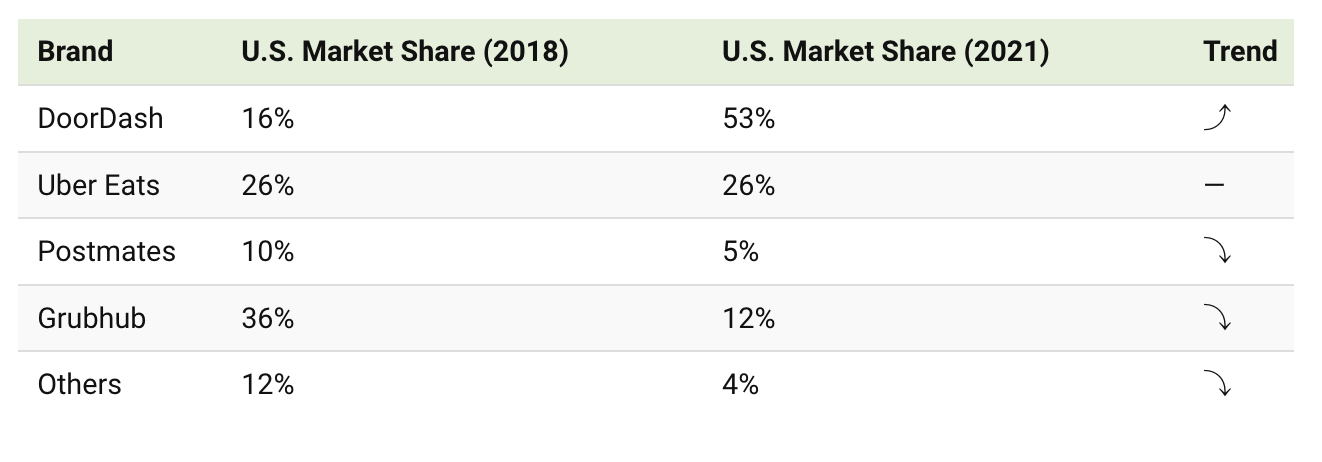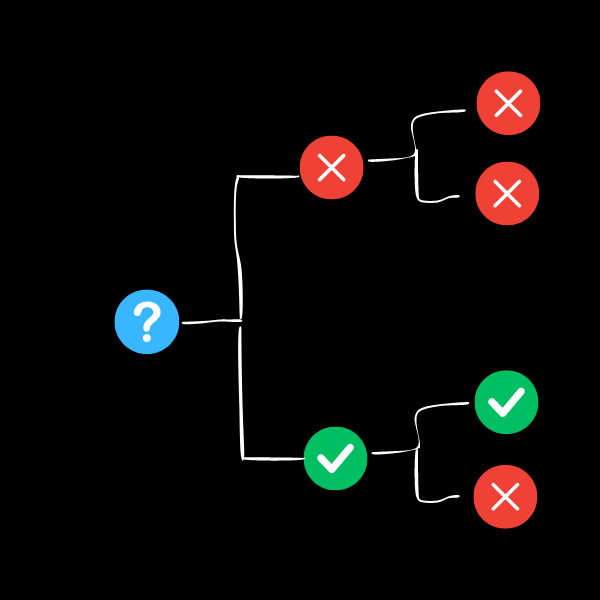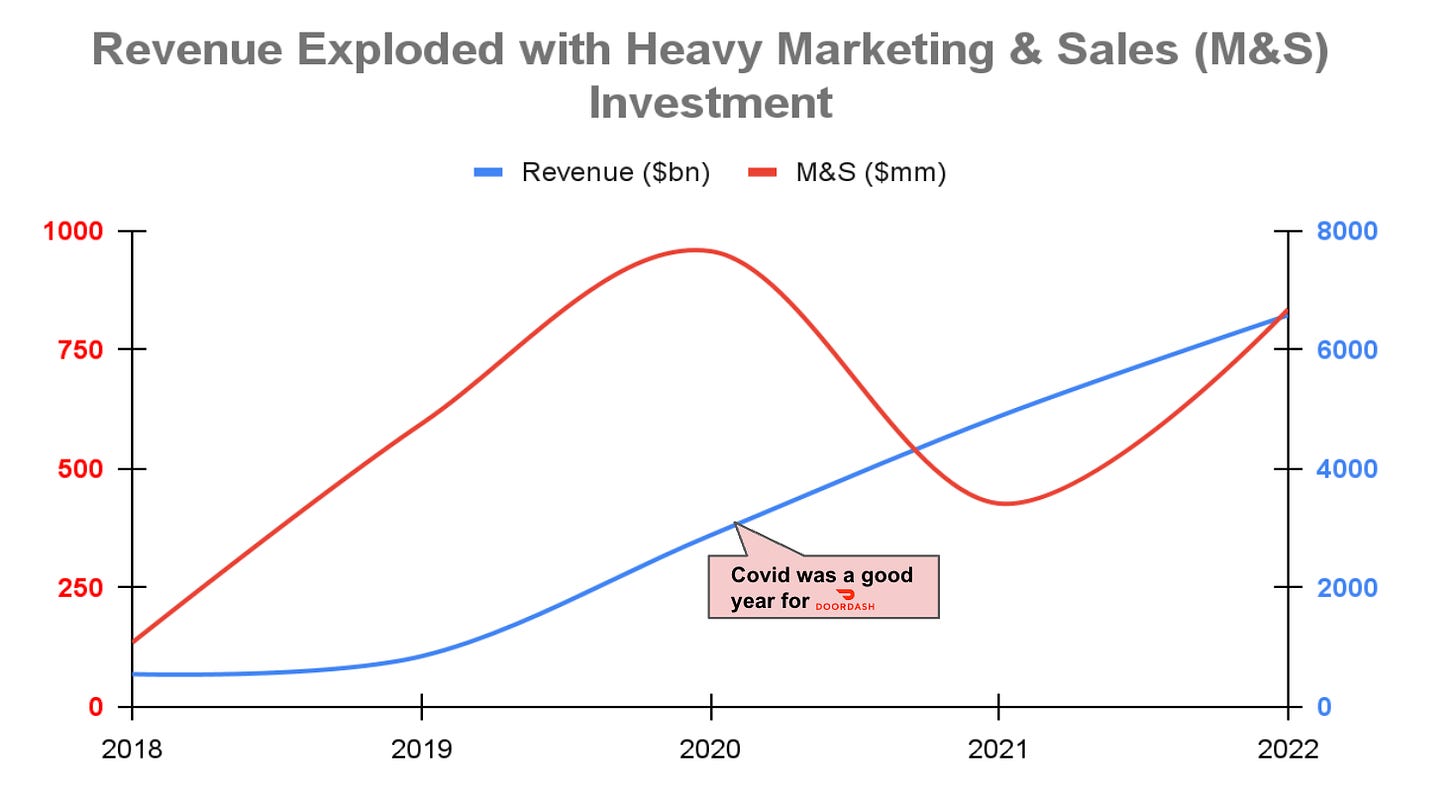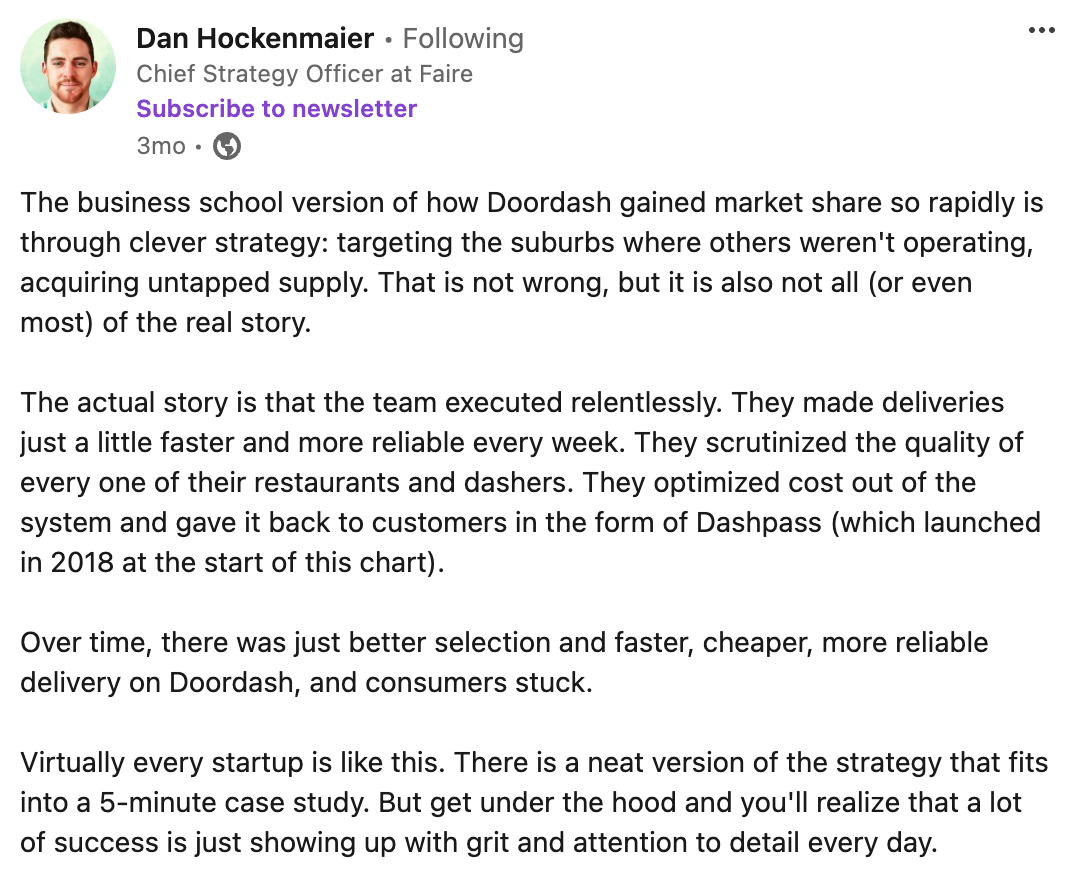Hello Readers 👋
How are you? I’m back in India and getting used to the humid Delhi weather and ripening mangoes. It’s a summer treat.
But enough about mangoes, because another essay is ready. After ‘what is strategy’, we’ll dig into ‘how’ to do strategy.
To keep it real, we’ll examine a business known for its structured thinking approach in a highly competitive space: DoorDash, the US food delivery market leader.
Let me know what you think in the comments.
Thanks for reading :)
Best,
Ved
When you hear the word “Strategy”, what do you imagine?
Is it:
A 160-page market study with charts and numbers?
A brand campaign or slogan? (e.g. “I’m Lovin’ It” or “Be The Best”)
The CEO’s vision?
While related, this isn’t a strategy.
A strategy is a set of choices to improve the competitive advantage of an organization. These choices help achieve a significant goal.
But in every story, where there’s a goal, there’s an obstacle. And that’s where strategy comes in.
Because strategy is for problem-solving.
In this piece, we’ll go beyond ‘what is strategy’ to ‘how to make one’.
To be less abstract, we’ll use DoorDash, the current US food delivery market leader.
And, how they captured 67% of US market share (as of 2024) from ~16% in 2018.
2013: DoorDash Asks ‘Who Isn’t Being Served?’
Launched in 2013, DoorDash saw an underserved market.
The food delivery space was a market with established competitors such as Postmates and Grubhub. But, they were just aggregators.
Serving as lead generators for restaurants who already owned their driver fleet.
And this meant over 70% of the US wasn’t getting food delivery.
With mass-market smartphone adoption, DoorDash saw an opportunity:
Consumers could order from anywhere.
Couriers (“Dashers”) could access the network from their devices.
Restaurants could accept orders via tablets/iPads.
With strong tailwinds and a large gap in the market, what could go wrong?
Well, by 2017, DoorDash ran out of cash.
2018: A $500M Revival To Beat Down Competitors
“I think the first lesson that we learned is what’s..the almost overly simplified problem that you’re trying to solve and, if you can ask yourself that question very crisply, I think that’s a very clarifying way to..test ideas.”
- Tony Xu, Founder and CEO of DoorDash
2017 saw DoorDash scrambling for money. Food Delivery businesses are capital intensive and competing with rivals like Uber drained DoorDash’s war chest.
By 2018, they raised $500M from Softbank, making them a unicorn.
DoorDash was back in the game, but they had to face their Problem:
How to increase market share?

Answering that question is where structured problem-solving plays a role.
(Note: I have not worked at the Strategy & Ops team at DoorDash. This is my attempt/best guess to show how structured problem-solving is used to develop a strategy/decision. As a result, I only have access to public data since their IPO.)
First, we need to clarify the objective and any boundary conditions for the problem:
Objective: To become a market leader (currently they own 16%)
Timeline: Medium-term (next 3-5 years)
Constraints: Focus on the US market.
Business Model: For simplicity, we focus only on the food delivery business for DoorDash. DoorDash also has a subscription model service called DashPass but we will treat it as out of scope in this piece.
Second, we need to break down this problem as a growth strategy case:
The three revenue levers of DoorDash are:
Total Order Volume (#orders)
Average Order Value (AOV)
Take-rate or Commission per Order (fees from restaurant, delivery, and customer)
For this problem, we will double-click on Total Order Volume:
# Customers = (#existing customers - #churning customers) + #new customers
#Average Orders/customer/year
With this breakdown, we can see the problem as mini-problems or issues:
How to increase the number of customers?
How to engage better with the existing customer base?
How to find new customers?
How to increase the number of orders per customer?
Let’s assume through analysis, that we prioritize the problem of finding new customers. Because the existing customer base is saturated it’s not possible to influence an increase in orders.
Following this line of thinking, we can understand DoorDash’s strategic move: focusing on restaurants in the suburban markets.
“By targeting a very focused greenfield opportunity, DoorDash was able to efficiently prove their model, building liquidity and market leadership.”
- Sarah Tavel, General Partner at Benchmark
This made sense for two reasons:
Expansion into less contested suburban markets gave Doordash a large advantage over competitors like Uber Eats, who were focused on more dense urban areas.
Suburban orders tend to have larger AOV
The key drawback with this move is how expensive it is to serve the suburban market, due to the distance and lack of density.
But, with their revenue growth, DoorDash used a growth-at-all-costs playbook with a massive investment in Sales & Marketing during this period.
Taking a Step Back: Strategy Is Just A Hypothesis
“DoorDash is a pretty strong writing culture … these documents are ... hypothesis trees..where we’re guessing what the problem is.
..We’re…looking for the disconfirming evidence to try to see whether or not we’re just confirming our own bias or … we’re on the right path to seeing what the right problems are.”
Tony Xu, Founder and CEO of DoorDash
The approach highlighted with DoorDash is the structured problem-solving method used by consulting firms:
State the problem and define the key question.
Structure an approach by breaking down the problem into smaller problems. (i.e. an issue tree).
Analyse your hypothesis and each ‘smaller problem’ and find data/reasoning to support your thought process.
Synthesise & Recommend a strategy to ‘win’
It’s worth mentioning, that strategy is only the first step.
In a business like food delivery, with Winner-Take-All dynamics, execution, and operational effectiveness are king.
Attention to detail. Cost optimization. Customer-first focus. These are some of the qualities that served DoorDash well.
However, the wrong strategic moves can also burn established players, as DoorDash’s competitors saw. In the end, you need both strategy and execution.
The key points about strategy is:
It serves to solve The Problem, sometimes with a structured problem-solving approach.
It is at best, a smart guess. (backed by data and logic)
But there is another concept with strategy aside from problem-solving: how to create a sustainable advantage.
That’s for another essay.
Want to go Deeper?
On DoorDash:
On Structured Problem Solving:








Great business breakdown!
DoorDash reminds me a lot of PDD/Temu. The way the entered very mature markets by targeting under-served segment.